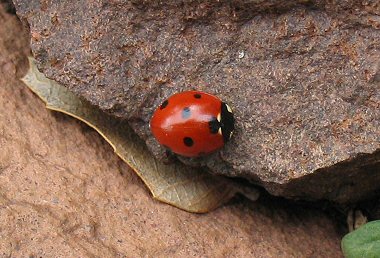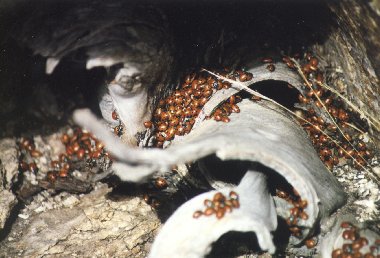There are about 5000 species of ladybug
throughout the world and they can survive in a variety of habitats,
including forests, fields, grasslands, gardens, and even in people's
houses. Like all beetles, the ladybug undergoes a complete metamorphosis
during its life. The life stages of the ladybug are: egg > larva >
 pupa
> adult. When they are not flying, the flight wings are covered and
protected by a pair of modified wings (called elytra). When
flying, the elytras open up, allowing the wings to move. Females are
larger than males. pupa
> adult. When they are not flying, the flight wings are covered and
protected by a pair of modified wings (called elytra). When
flying, the elytras open up, allowing the wings to move. Females are
larger than males.
|
In cooler weather on mountain
tops, ladybugs gather together in clumps to conserve heat. |
Ladybug larvae and adults eat aphids, mealybugs, and
mites. Ladybug larvae can eat about 25 aphids a day; adults can eat over
50. Female ladybugs lay tiny eggs, usually laid in a small mass. The
larvae that hatch from the eggs are small and long and have 6 legs. As it
rapidly grows, the larva molts (sheds its skin) several times. After
reaching full size, the larva attaches itself to a plant leaf or stem.
The larval skin then splits down the back, exposing the pupa. The pupa
is about the size of the adult but is all wrapped up, protecting the
ladybug while the it undergoes metamorphosis into its adult stage. This
last stage in the metamorphosis takes a few days.
 |

